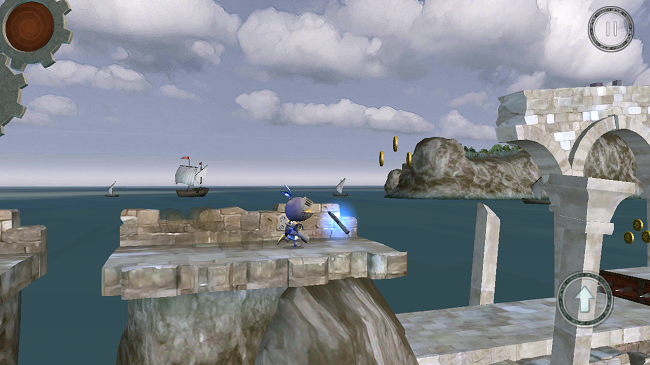P1
My Game Idea Research
The main premise of this game idea is to make a 3 laned 3D side scroller. It will have the player moving across a continuously changing terrain as they fight a variety of enemies, pick up weaponry and use the 3 lanes to get to the end of the level. We will aim for the game to be rated as PG at the very highest so it will be a light-hearted comedy/adventure game.
This idea stems from the lack of both shooter games within the trending page and the lack of full 3D side scrollers. From my research, I have found that many games that claim to be a 3D side scroller have a 3D environment but don't allow the player to explore the world along the z axis (See example).

However, I did Find 3 3D side scroller games that do let the players travel across the z axis. These games are Little Big Planet, Little Nightmares and Super Mario 3D world. All three of these games have a different genre. Like Night little Nightmares is a horror game where-as Light Big Planet and Super Mario 3D are not. There is one genre the all have in common and that's "Adventure Game". I believe this is because side scrollers give the player a limited view due to the close zoom and the small amount of adjustments they are given. Due to this, the player is always searching a discovering new parts of the game as they play.
(Super Mario World 3D - 2013)
(Little Nightmares - 2017)
(Light Big Planet 3 - 2014)
I think the best features across all 3 games is the simplistic puzzle aspect. The puzzles are the same across all games though. In Mario, it's having to find the quickest and safest way to get to the flag where-as in Littler Nightmares, it's having to use your surrounding objects to get to the next room and sneak past the enemies.
When you combine this with the an unrealistic art style that they all share (this could be uneven body proportions, non-human characters and other worldly levels), you come out with a simplistic yet fun game that can entice people of a variety of age groups.
Media that'll help us
For the art style of the game, I turned to the film How To Train Your Dragon. The film is set in a fictional Viking world so it's most likely set between the 8th and 11th century although no date has actually been given. However, the art style shows vast open areas of green with mountains and hills. The building are made of wood and are very simplistic.

A well known technique within the movie industry is breaking the forth wall. It is usually used for comedic purposes but could also be used to show what the character is thinking and to clarify plot points. I think breaking the forth wall would be a great comedic addition to the game and films like Ferris Bueller's Day Off or a series like Malcolm in the Middle could give us some insight on how it's done.

Another form of media that'll help us would be social media. Not only would it help us communicate with other developers for advice or there contributions whether it be sound design or voice acting, but we can use it for feedback. If we were to release beta versions of the game for free so people can download it then they can pla it and provide feedback. An alternative would be to record ourselves playing it an upload it various different social media platforms so we can get feedback that way.












Design Values Triangle

GDC Talk
http://www.gdcvault.com/play/1023762/A-Geographer-s-Guide-to
Every game has a "world". Anything that has a surrounding or environment with it's own laws is a world. This can range from something as detailed is GTA 5's Los Santos to Angry Birds. Also, it's good to note that in order for a world to be good, it doesn't have to be realistic. A world is about realisation; not realism. The key focus shouldn't be adding mass amounts of detail, it should be about telling narrative.
Quick Recipe to Realising Worlds
- A suggestion of familiarity. This means that when you experience the world, you feel as though it could be real.
- A hint of complex systems. Our world is so complex that there's no way we could represent all of it but we can hint as it through artefacts, hints of the world through objects or characters.
- A dash of cultural evidence. Having a sense of culture (past or present) that lives in the world to bring it to life.
- A Big chunk of logical consistence. Don't make something so random that it doesn't fit with the rest of the world. There are always rules to space, time and all elements. Making these rules and following them helps the world feel real and lowers contradiction. This applies to every object, environment and character.
- A hint of topology (Connectedness). How are attributes, characters and objects connected to each other and the world?
- Backfilling . the process of added props or extra detail to making the world. Eg, haystacks and/or banners in a medieval game. Everything need to be made with a purpose - don't be lazy.
Set the context
Real world vs Fictional World
Real worlds primarily emphases is on replication and authenticity
Fictional world primarily emphases is on imagination and distinction.
Real world primarily emphases on realism and an experience that feels genuine
Fictional world primarily emphases on discovery and an experience that provides escapism.
Primary issues:
Real World
Augmentation
Accuracy
Interpretation
Appropriation
Fiction World
Generalisation
Emulation
Allegory
Artefacts
Both
Logical Consistence
Managing the creation of cultural evidence
Production visioning by language/locale
Discoverability of issues
After recording the paper prototype for our game, we noticed a few things. Firstly, we were able to see how the game would be considered fun. I believe one of the entertaining parts would be the survival aspect. The player is faced with a seemingly endless oncoming enemies, so I think the player's ability or inability would create the right kind of the challenge for the game. Secondly, The collectables within game could add some depth to the game. The ideas we had about would greatly entice the players to play again to collect them. Our ideas were to have one collectable that (if all were collected) would grant the player with an additional life. Since this is the only way for the player to increase their life count, it would be in the player's best interest to learn where the collectables are. The second collectable would be a lot harder. Not only would they be in more difficult spots to reach but there would be a lot more of them. However, if a player is able to collect all of them then they would be rewarded with a different end cutscene that is the "Good Ending" instead of the "Bad Ending" they would otherwise get.
There were a few bad things I learned from the paper prototype. One is that the art style represented looked rather generic and unoriginal. To get around this, we will make sure to spend more time in the concept phase to get the art style perfect before production. The second issue is it being repetitive. It's possible that the game's attack against the oncoming enemies would be too repetitive for the player and may lose their interest. We did have ideas of adding new weapons for the player to use as they progress throughout the level but we have to make sure that each weapon has a unique feel that is both satisfying and different to any other form of attack.





































Comments
Post a Comment